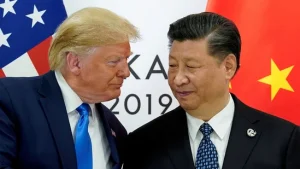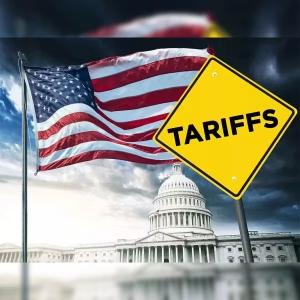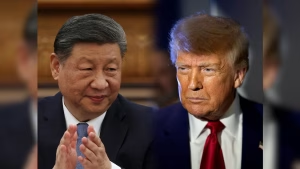Washington D.C. – President Donald Trump announced a crucial 90-day extension for Trump China Tariffs negotiations, posting on his Truth Social platform that he signed an executive order maintaining the current trade truce between the world’s two largest economies. This Trump China Tariffs extension prevents a dangerous economic showdown that could have severely impacted global markets and bilateral trade relationships.
The Trump China Tariffs deadline was originally set to expire at 12:01 a.m. Tuesday, which would have automatically triggered significant tariff increases. Without this extension, the Trump China Tariffs could have escalated from the current 30% to even higher levels, while Beijing prepared retaliatory measures against U.S. exports to China.
Critical Timeline and Market Implications

The Trump China Tariffs extension provides essential breathing room for diplomatic negotiations, potentially clearing the way for a summit between Trump and Chinese President Xi Jinping later this year. This strategic pause in the Trump China Tariffs escalation has been welcomed by U.S. companies conducting business with China, who feared immediate disruption to their supply chains and market access.
Sean Stein, president of the U.S.-China Business Council, described the Trump China Tariffs extension as “critical” for providing both governments sufficient time to negotiate a comprehensive trade agreement. The extension enables businesses to maintain medium and long-term planning capabilities without the uncertainty of immediate tariff increases.
Business Community Response and Market Access Concerns
The business community’s relief regarding the Trump China Tariffs extension reflects deep concerns about market access and operational certainty. U.S. companies have expressed hope that negotiations during this extended period will improve their market access in China while providing the stability needed for strategic business planning.
Stein emphasized that securing an agreement addressing fentanyl issues could lead to reductions in the Trump China Tariffs and rollback of China’s retaliatory measures. Such agreements are considered essential for restarting U.S. agriculture and energy exports, which have been significantly impacted by the ongoing trade tensions.
Global Trade System Transformation

The Trump China Tariffs represent part of a broader transformation that has fundamentally altered the global trading system. Trump has implemented double-digit tariffs on almost every country worldwide, forcing traditional trading partners to accept previously unthinkable trade arrangements to avoid worse consequences.
The European Union, Japan, and other trading partners have agreed to lopsided trade deals, accepting high U.S. tariffs of 15% on imports to ward off more severe measures. These agreements demonstrate how the Trump China Tariffs strategy has influenced America’s approach to international trade relationships across all major economies.
Protectionist Policy Impact and Historical Context
Trump’s trade policies, including the Trump China Tariffs, have transformed the United States from one of the world’s most open economies into a protectionist fortress. According to the Budget Lab at Yale University, the average U.S. tariff has increased from approximately 2.5% at the beginning of the year to 18.6%, representing the highest levels since 1933.
Also Read: US Designates Balochistan Liberation Army as Foreign Terrorist Organization
This dramatic shift illustrates how the Trump China Tariffs and broader trade policy represent a fundamental departure from decades of American trade liberalization. The current tariff levels demonstrate the administration’s willingness to use economic tools as diplomatic leverage.
Chinese Strategic Response and Rare Earth Leverage

China has tested the limits of U.S. trade policy built around using tariffs as negotiating tools, demonstrating its own economic leverage through control of rare earth minerals and magnets. These materials, essential for electric vehicles and jet engines, provide Beijing with significant bargaining power in negotiations surrounding the Trump China Tariffs.
In June, both countries reached an agreement to ease tensions, with the United States agreeing to reduce export restrictions on computer chip technology and ethane, while China facilitated U.S. firm access to rare earths. This agreement represents the type of mutual concessions that could emerge from extended negotiations.
Previous Escalation and Market Impact
In May, the U.S. and China averted economic catastrophe by reducing massive tariffs that had reached 145% against China and 125% against the United States. These triple-digit tariffs threatened to effectively end bilateral trade and caused significant financial market sell-offs before both countries agreed to reduce them to 30% and 10% respectively.
The experience with extreme tariff levels demonstrated both countries’ ability to inflict economic damage while highlighting the need for ongoing diplomatic engagement. This history provides context for understanding the current Trump China Tariffs extension’s importance.
Expert Analysis and Future Prospects
Trade specialists suggest that the Trump China Tariffs extension reflects the administration’s recognition that unilateral leverage has limitations. Claire Reade, senior counsel at Arnold & Porter and former assistant U.S. trade representative for China affairs, noted that “The U.S. has realized it does not have the upper hand” in these negotiations.


Ali Wyne from the International Crisis Group observed that the administration’s desire for trade détente stems from “self-inflicted consequences of its earlier hubris,” suggesting that the Trump China Tariffs strategy may require fundamental recalibration.
Long-Term Trade Relationship Outlook
While the current Trump China Tariffs extension provides immediate relief, experts remain skeptical about comprehensive resolution of underlying trade disputes. Jeff Moon, former U.S. diplomat and trade official, predicts that “the trade war will continue grinding ahead for years into the future,” suggesting that the extension merely postpones rather than resolves fundamental economic tensions between the two nations.

